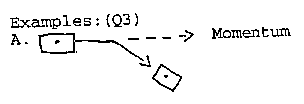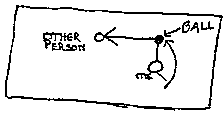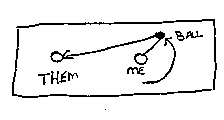 |
 |
|
|
|
|
ME126 Form Item Description: This exercise demonstrates three ideas about circular motion.
The first part of the assessment is designed to teach the students some of the concepts involved. This section calls for students to make observations about the activities and while insight can be gained about their performance, this section will not affect the students' score. The second part contains three questions which will be used to score this event. The first question is about an activity where students swing a ball in a plastic bag over their head and try to release the bag so that it flies to their partner. For a complete answer, the student should show the correct location where the ball is released and that the ball travels in a straight line. Either one of these is usually enough to get the student one of the points. As always though, the student should make the ideas clear. For the second question, students should show a marble moving around the edge of a 3/4 pie plate. When the ball reaches the edge it should roll off tangent to the plate. This is the direction of its final motion on the plate. This question must be totally correct to pass criteria 1 due to its simplicity. In question 3, students explain why we feel like we are being pushed against the car door when a car turns. When the car moves into a turn, our bodies naturally tend to continue in straight line motion. We move straight until some force acts to change our direction. When the car turns right, the left side of the car pushes us toward the new direction. Students must express the idea that the car pushes us and that we tend to go straight to get full credit.
Rubric Criteria 1:
Criteria 2: Student clearly shows straight motion in two of the three questions. For question 1 they must state that the ball flies straight after being released. Any mention of the ball flying circularly after release is not acceptable. For question 2, the criteria are the same as for criteria 1. For question 3, the student mention that the bodies tendency to go straight or forward. This may be attributed to inertia or momentum as long as the person's straight motion is mentioned. Examples: (Q1)
Examples: (Q3) 
B. Your body wants to go in a straight line. C. The car turns but you go straight. Usually this will be satisfied
by having Q2 and one of the others. The student has the release point correct for question 1. A correct release point is anywhere in the following range. Students may describe this as on the side or to their right (or left) as long as the ball is not behind them at all. Students may mention curved motion after release. Example:
Criteria 3: Idea of straight motion is communicated in question 1 or 3 and is not contraindicated in any of the three questions. If the students mention straight motion in Q1 or Q3 and don't describe motion at all in the other, that is acceptable. However, any mention of the ball curving after being released (Q1) or the marble curbing after moving off of the plate (Q2) prevents getting this point. Criteria 4: Student explains that the body in the car moves in a straight line forward until the car acts on it. (Q3) Eventually the person will move in the same direction as the car. Simply saying that the person moves with the car is not sufficient. Examples:
The student identifies a correct point and that the ball flies straight (Q1). The method for assessing these separately is given in the description for criteria 2.
|

 They didn't
explain what happens next.
They didn't
explain what happens next.
 Ball is moving
in wrong direction.
Ball is moving
in wrong direction.

 Note: Release
is not correct but the ball is shown traveling straight.
Note: Release
is not correct but the ball is shown traveling straight.
